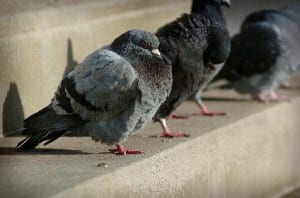Pigeons and humans have co-existed for thousands of years. But when they become a nuisance, who is to be blamed?
 Pigeons, one of the most resourceful species on the planet, are traditionally, symbols of love, peace, family and faithfulness. Their inflated throaty coos are a common sound in virtually every part of the globe with the exception of the Sahara Desert and the Polar ice caps. It is ironic that the species is currently being referred to as “the most serious bird pest associated with human habitations”.
Pigeons, one of the most resourceful species on the planet, are traditionally, symbols of love, peace, family and faithfulness. Their inflated throaty coos are a common sound in virtually every part of the globe with the exception of the Sahara Desert and the Polar ice caps. It is ironic that the species is currently being referred to as “the most serious bird pest associated with human habitations”.
Flock together
Pigeons have lived alongside humans and been used for food, sport and as messengers. Considered one of the most intelligent species on the planet, pigeons can perform tasks previously thought to be the sole preserve of humans and primates.
Descended from wild rock doves that thrive in a cliff environment, feral pigeons form large flocks that roost on building and ledges and under bridges. They can often be found in loft spaces and empty buildings — anywhere that offers a small amount of shelter.
Naturalist Dr. T. Murugavel says, “Feral pigeons thrive in urban areas in particular because there is usually a good food source and the absence of predators. The result is that they can become ‘pests’ in built-up areas. Unless food is strictly controlled, pigeons will rapidly breed out of control, resulting in overpopulation in areas of human habitation. Researchers have proved that pigeons do not usually like any change in their nesting area. Even a decoy or an image of a raptor when placed in the nesting or roosting area of pigeons discourages them from nesting. Whatever you do, ensure that it is humane and eco-friendly.”
Research conducted around the world to find a humane way to control, includes methods like ‘birth control’ pellets to controlling the number of eggs allowed to hatch, spikes to deter landing and thorny cacti on a sunny windowsill! But aren’t ‘pigeon problems’ really ‘people problems’? Can we coexist better with a bird that has survived in close association with man for over 10,000 years?
A recent report in The Independent spoke of how people found feeding pigeons in the Austrian city of Vienna were to be fined €36 in an attempt to keep the city clean. Pigeon experts from the animal welfare ombudsman said that it was rubbish in the city that caused problems beyond the pigeon population. Obviously, unclean neighbourhoods in any part of the world are the reason for many health and environmental issues, but looks like it is the issue that is being most conveniently pigeonholed!
Shoo!
The National Audubon Society Birds site, which gives tips on “how to shoo them away”, says that many safe and effective commercial products are also available including plastic or metal bird spikes. If pigeons are roosting on a utility wire or other area where they can’t be easily blocked, a weatherproof bird sound device that plays bird alarm or distress calls may chase them away.
Downside
Pigeon droppings are acidic and can cause damage to buildings and machinery. Nesting material, droppings and feathers can block drains and air vents. Startled flocks that take flight suddenly may cause hazards to motorists and pedestrians. While large numbers of pigeons can drive smaller birds away from feeding areas, they can also spread disease to other birds.

